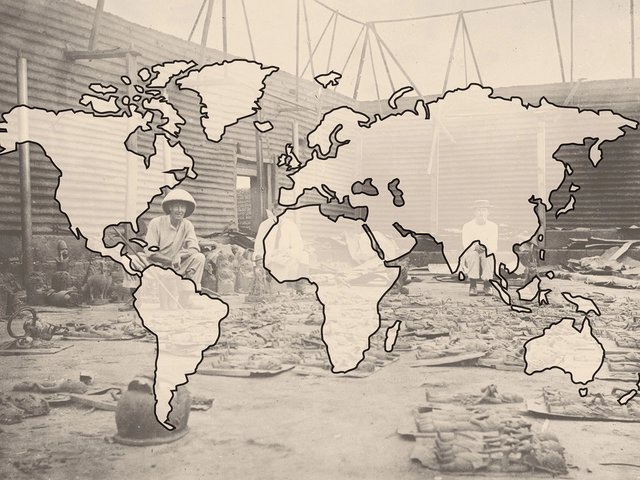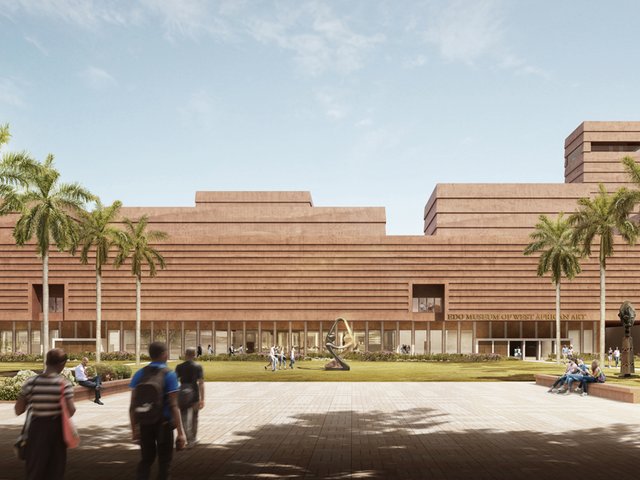A new museum in the historic heart of Benin City in Nigeria is opening its first building on 4 November. The Museum of West African Art (MOWAA) Institute, designed by Adjaye Associates, aims to fill an urgent need in the region for training in archaeology, conservation, heritage management and museum practice.
The building, set within the ancient moats of the Benin Kingdom, comprises an auditorium, storage, a conservation lab, conference rooms, a library, exhibition space, offices and an outdoor amphitheatre. Built of rammed earth, it offers a total space of about 4,000 sq. m.
“It’s the core engine for the whole of the campus,” says Phillip Ihenacho, the executive director and chairman of MOWAA, which organised the Nigerian pavilion at the Venice Biennale this year. Other buildings still in the planning stages are the Rainforest Gallery, the Artisan Hall (a performance venue with retail space for local craftsmen), a material science lab, a boutique hotel and gardens and a sculpture park.
The whole campus is expected to cost around $100m, including construction and an endowment fund to cover operational costs, Ihenacho says. So far, MOWAA has raised about $20m from sponsors including the state of Edo (where Benin City is located), the German and Nigerian governments, the Gerda Henkel Foundation, the Deutsche Gesellschaft für Internationale Zusammenarbeit, Open Society Foundation and the Ford Foundation. A recent addition is the Mellon Foundation, which has granted $3m for MOWAA’s training programmes, including residencies and arts management and conservation.
“We are not trying to raise it all in one go,” Ihenacho says. “We’ll address each piece individually.” He hopes that by the end of next year, MOWAA will have funding for at least one or two more of the planned buildings.
A live archaeological dig
The opening of the MOWAA Institute will include a “live archaeological dig, in part because that has been so much a part of what we’ve been doing over the last two to three years”, says Ore Disu, the institute’s director. MOWAA teamed up with the British Museum, the German Archaeological Institute and the Nigerian National Commission for Museums and Monuments to excavate at the site of the museum. The finds, which include pottery dating back 800 years, will form part of the inaugural exhibition, opening in May 2025, Disu says. The show will also incorporate contemporary art.
The main focus of the new institute is conservation, Disu adds. “We’re already in discussion with a couple of museums in Nigeria and a few other places, like Senegal and Ghana, as to what their conservation needs are and whether, for example, they would be interested in sending their conservators or collections staff to come and spend time with us,” she says. “A lot of the conservation methodologies here have been typically defined by what is required in more temperate climates and access to particular types of facilities and resources that aren’t readily available on this continent. We’re going to have to think more creatively.” This will include examining “Indigenous technologies and approaches that have been less studied and understood”, Disu says.
There will, however, be no Benin Bronzes on show at the museum—at least for now. While the Edo state government had initially envisaged MOWAA as a repository for sculptures and other artefacts repatriated from Western museums, that changed in 2023, when the outgoing president declared the Oba, or king of Benin, to be the rightful owner of the returning bronzes.
Ihenacho says that MOWAA is “available as and when we are needed” to conserve or exhibit the bronzes. “But we didn’t want to get further entangled in any sort of dispute around to whom these objects should be returned,” he says.





